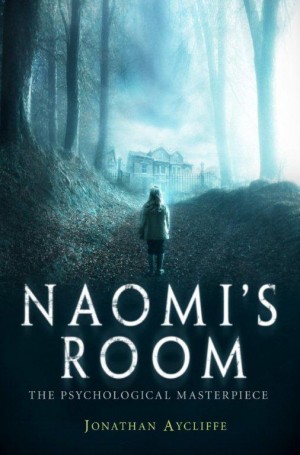 One of the biggest questions facing an author of a haunted house story is, what can keep the protagonists in the house once the scary stuff really gets going. Here are two books, the ninth and latest supernatural/ghost novel from Jonathan Aycliffe, together with a reprint of his first ghost story dating from 1991, which address that question head on with very different results.
One of the biggest questions facing an author of a haunted house story is, what can keep the protagonists in the house once the scary stuff really gets going. Here are two books, the ninth and latest supernatural/ghost novel from Jonathan Aycliffe, together with a reprint of his first ghost story dating from 1991, which address that question head on with very different results.
Naomi’s Room is narrated by Charles from the vantage of 1990, reflecting on the terrible events of Christmas 1970 and beyond. Charles and his wife Laura (the first of many Don’t Look Now references without which the book would be stronger) are academics living in an old Victorian house in Cambridge. On Christmas eve their four year old daughter, Naomi, disappears and is found murdered, horribly mutilated. Mysterious children are seen, there are screams in the night, footsteps in the attic.
A Welsh photographer, Lewis, who Charles can only describe in terms of cliche – alcohol, rugby, sheep farming, mines – shows the couple mysterious images which have appeared in his photographs of their house. One foreshadows the murder of the detective leading the investigation into Naomi’s death. Yes, Lewis has the David Warner part from The Omen. Eventually it all turns into a homage to The Shining.
And meanwhile as the narration shifts between 1970 and to 1990 the reader is forced to ask why, 20 years later, Charles is still living in this terrible, actively haunted house. Fortunately Aycliffe is able to provide an excellent reason which proves integral to the story, and while not every aspect of the plot comes together satisfactorily he takes the tale into some surprising, shockingly dark territory.
Charles investigates the history of his home – Laura is rather sidelined – and discovers the traditional Very Bad Things, which provide a solid underpinning for the horror. His researches are expertly interwoven with nightmarish set-pieces which, for all their reworking of time-worn tropes, send shivers down the spine. While the mayhem which occurs outside the family home feels not entirely convincingly connected to the supernatural events inside the house everything in the home itself works marvelously. The last 30 pages ratchet the terror up to 11 as Aycliffe drags the classic haunted house atmospherics kicking and screaming into full-blooded post-Barker Gothic horror. I read Naomi’s Room in a day. It’s that gripping.
 In The Silence of Ghosts Dominic, following a disabling combat injury, has been dispatched from London by his unloving parents to the family house in the Lake District. From the start this fails to convince – in 1940 the Royal Navy would not have discharged an otherwise healthy young officer in his early 20s ‘only’ because he has lost a leg below the knee. We know that many men who suffered serious disabling injuries returned to active duty – Douglas Bader is the famous example in the RAF – but if not active service, the navy would have found Dominic a desk job. Equally it seems unlikely that his rich family, however unloving, would pack him off to a cold, isolated house with only the company of his deaf ten year old sister, Octavia, who has previously never been outside London, and no nursing care or other support arranged.
In The Silence of Ghosts Dominic, following a disabling combat injury, has been dispatched from London by his unloving parents to the family house in the Lake District. From the start this fails to convince – in 1940 the Royal Navy would not have discharged an otherwise healthy young officer in his early 20s ‘only’ because he has lost a leg below the knee. We know that many men who suffered serious disabling injuries returned to active duty – Douglas Bader is the famous example in the RAF – but if not active service, the navy would have found Dominic a desk job. Equally it seems unlikely that his rich family, however unloving, would pack him off to a cold, isolated house with only the company of his deaf ten year old sister, Octavia, who has previously never been outside London, and no nursing care or other support arranged.
These aspects aside, the story is well told through Dominic’s diaries, though a framing device in which Dominic’s grandson Charles serves as a present day editor immediately undermines the suspense by revealing in the introduction that at least two main characters will survive. Happily Dominic and Octavia and a likable pair, and the reader is soon having an enjoyable time as they find themselves spooked in a classic English haunted house, complete with ghostly children, and … something else.
The first half of the novel offers a series of effective set-pieces which deliver the requisite chills, while also telling the routine but serviceable love story of Dominic and his nurse, Rose. This really is a standard issue wartime romance which plays on changing social mores as approaches to love and sex undergo whirlwind transformations in a world overshadowed by the specter of sudden death. So far, so functional, but then halfway through the novel something so terrifying happens everyone flees the house, quite sensibly determined never to go back. And while Aycliffe does not contrive a means to keep his characters in the house, the effect is that the story loses focus between events involving the local community – the village doctor and vicar become major characters – and a return trip to London.
There is a subplot about an unidentified disease, and an interesting thread in which it appears that it is Octavia’s deafness which enables her to hear the voices of undead. There are deaths, but no one seems sufficiently concerned or grief-stricken. Charles investigates the history of the house, which is tied to his family’s centuries old business connections with Portugal. This in itself is intriguing, but it is never sufficiently developed or urgent. Though the house does have a peculiar history what follows is neither entirely coherent nor compelling. The supernatural events ultimately are so arbitrary and random we are forced to ask, what, exactly, do the ghosts want? Uncanny events transpire because they are the sort of things – the stock haunting devices which worked so well in Naomi’s Room because they were properly integrated into that narrative – which always happen in ghost stories. So they happen here. Regardless. But what is the purpose of the dancing? What was the thing on the stairs? Why the tragic incident on the lake? Why does Octavia have the same name as one of the children on a certain list? Who knows? On all these subjects the ghosts remain silent.
Unfortunately the novel becomes less gripping as it goes on, with the love story marginally more engrossing than the underdeveloped supernatural tale. They may be stock characters, but Dominic and Rose are engaging. Dominic’s cold, possibly sociopathic parents, are compelling characters, though perhaps under-utilized and too easily written out. The home front world of rationing is well captured and there is some interest in the presentation of historical attitudes to disability. But the language is wrong, people talked about cripples and the handicapped, not the disabled, in 1940. Ultimately too much simply doesn’t add together and a last page twist makes no psychological sense. As a thriller The Silence of Ghosts wouldn’t trouble a lamb.










